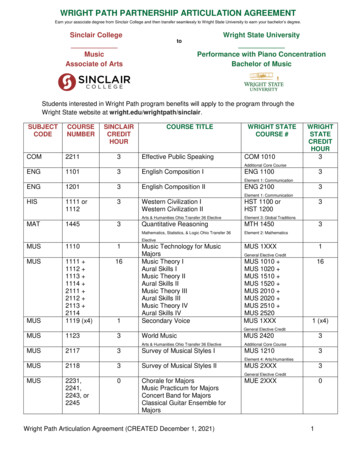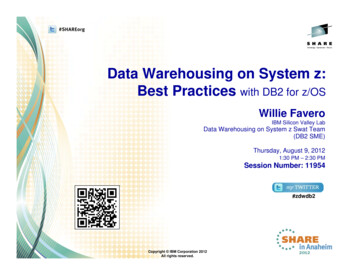
Transcription
High Performance/Parallel ComputingAndrew ShermanSenior Research Scientist in Computer ScienceYale Center for Research ComputingDepartment of Computer ScienceNational Nuclear Physics Summer SchoolJune 25, 2018
What is High Performance Computing (HPC)?Using today’s fastest computers (“supercomputers”) to solvetechnical computing problems (mostly in science and engineering).Often computations involve parallel computing.Why is HPC interesting to scientists and engineers?– Short answer: Better computational results– More details: Could solve the same problem faster: Might be the key to making an application feasible (e.g., weather forecasts) Could repeat a calculation with multiple parameter sets to find the best one Could solve larger/more complex problems in the same amount of time Might lead to better models that are more accurate and realisticYale Center for Research Computing06/25/2018-2
Why should you care about HPC? Research: Broad range of research in science, engineering, and other fields Applications: Important “real-world” applications: weather, data analysis, AI,personalized medicine, machine learning .Riken AICS, 2011Yale Center for Research Computing06/25/2018-3
Familiar Example: Weather ForecastingAtmosphere modeled by dividing it into 3-dimensional cells.Temperature,pressure,composition, etc.Calculations for each cell repeated many times to model passage of time.Yale Center for Research Computing06/25/2018-4
Why is Global Weather Forecasting Challenging? Suppose whole global atmosphere divided into cells of size.125 mile .125 mile .25 mile to a height of 12 miles(48 cells high)Þ about 1.3 10 11 cells. Suppose each cell update uses 200 arithmetic operations.Þ For one time step, 2.5 x 10 13 arithmetic operations are needed. To forecast the weather for 7 days using 1-minute intervals to trackchanges, a computer operating at 20 Gigaflops (2 x 10 10 arithmeticoperations/sec) on average would take 1.25 x 10 7 seconds.Þ It would take over 20 weeks to simulate 7 days! To do this in 1 hour would require a computer 3500 times fasterÞ Computer speed of 70 Tflops (70 x 10 12 arithmetic ops/sec)Yale Center for Research Computing06/25/2018-5
Parallelism Makes Weather Forecasting FeasibleHow can this sort of performance be achieved? Divide the problem among many individual processors (computers)5612834 But the computations in each cell depend on nearby cells, so nowyou have to deal with interprocessor communication, as well as withthe computation. But with fast enough processors and a fastnetwork, this can be made to work pretty well.Yale Center for Research Computing06/25/2018-6
Another Example: Modeling Interacting BodiesEach body is affected by each other body through forces.Movement of each body in a short time period (a “time step”) ispredicted by evaluating the total instantaneous forces on eachbody, calculating body velocities, and moving the bodiesthrough the time step. Many time steps are required.Yale Center for Research Computing06/25/2018-7
Gravitational N-Body ProblemModel positions and movements of bodies in space subject togravitational forces from other bodies, using Newtonian physics.Example: Cosmological SimulationsIn 2005, the Millennium Simulationtraced 2160 3, or just over 10 billion,“particles” (each representing 1billion solar masses of dark matter) ina cube of side 2 billion light years.Required over 1 month of time on anIBM supercomputer, and generated 25 Terabytes of output. By analyzingthe output, scientists were able torecreate the evolutionary history of 20 million galaxies populating thecube.Yale Center for Research Computing06/25/2018-8
Approaches to Modeling Many-Body MotionStart at some known configuration of the bodies, and useNewtonian physics to model their motions over a large numberof timestepsFor each time step: Calculate the forces:– “Brute Force” Algorithm: With N bodies, N-1 forces to calculate foreach body, or approx. O(N 2) calculations (50% reduction for symmetry)Move the bodies to new locationsRepeatYale Center for Research Computing06/25/2018-9
Challenges in Modeling Many-Body Motion A galaxy might have 10 11 stars. So one time step would require:– 5x1021 force calculations using “brute force” Suppose that, using 1 computer, each force calculation takes0.1 µsec (might be optimistic!). Then 1 time step takes:– Over 1.6x10 7 years using “brute force” To make this computation feasible, you either need a MUCHbetter algorithm, or you need to find a way for many computers tocooperate to make each time step much faster, or bothYale Center for Research Computing06/25/2018-10
Algorithmic Improvement: Clustering ApproximationApproximate the effect of a cluster of distant bodies by treating them as asingle distant body with mass located at the center of mass of the cluster:Side length dAccuracy of this approach dependson the ratio θ d/r. (Smaller is better.)This idea leads to O(N log2N) algorithms for N-Body problems. The approachhas been “discovered” many times, including as the Fast Multipole Methodby Leslie Greengard and Vladimir Rokhlin at Yale.In astrophysics, the idea underlies the Barnes-Hut algorithm, which reducesthe serial runtime per timestep from 1.6x107 years to 4 days. Furtherimprovement can come from a “divide-and-conquer” parallel implementationbased on adaptively dividing the cube into many sub-cubes.Yale Center for Research Computing06/25/2018-11
Barnes-Hut ExampleInitial distribution of5,000 bodies in 2simulated galaxiesSource for this andother images and forvideo: Ingo Berg %E2%80%93Hut simulation)Yale Center for Research Computing06/25/2018-12
Barnes-Hut Full PartitionShows full partition for5,000 bodies, each inits own cell.(Empty cells omitted.)Yale Center for Research Computing06/25/2018-13
Colliding Galaxies %80%93Hut simulationYale Center for Research Computing06/25/2018-14
A bit of history: HPC’s not really new! People have been developing and using “supercomputers” for a long time “Ancient” history: Supercomputers were very large monolithic computers Limited amounts of parallelism were incorporated in them.IBM 7094(c. mid-1960s)CDC 7600 (c. 1970)(36 MegaFlops Peak)Cray 1 (c. 1976)(250 MegaFlops Peak)Your cell phone is surely much faster than these supercomputers:Online reports claim 1.2 Gigaflops or more on an iPhone 7Yale Center for Research Computing06/25/2018-15
Supercomputers TodayAs of 2018: Today’s supercomputers are highly parallel computers Most are networked “clusters” of many commodity processors Some use accelerators, such as special-purpose computers based on thegraphics processing units (GPUs) designed for desktop videoYale Omega Cluster (2009)5632 cpus57.8 Linpack TeraFlopsSunway TaihuLight (2016)10.6 million cores93.0 Linpack PetaFlopsWorld’s fastest (2016-2017)Yale Center for Research ComputingORNL Summit (2018)4608 nodes2.3 million cores6 NVIDIA Volta GPUs/node122.3 Linpack PetaFlopsWorld’s fastest as of June 201806/25/2018-16
Some reasons for parallel supercomputers Cost– Monolithic machines require huge investments by companies or by thegovernment for use by a relative handful of consumers– Parallel machines can be built by connecting commodity parts (e.g.,PCs or GPUs) whose cost is driven by huge standalone markets “Obvious” computational advantages– More processors Þ More independent computations per second– More memory Þ Less swapping & contention– More disks or other I/O devices Þ Faster aggregate I/O Good algorithmic fit to many problems– Many (most?) problems are “embarrassingly parallel” (e.g., MonteCarlo, parameter studies, etc.)– “Divide-and-conquer”: often a useful approach that is naturally parallel– “Assembly Lines”: another naturally parallel way to solve problemsYale Center for Research Computing06/25/2018-17
An even more important reason: Physics!We’ve been living off of Moore’s Law and Dennard Scaling.What do these really say? What are the ramifications for HPC? Moore’s LawDennard ScalingSmaller transistorsNirvana! Higher power densityMore powerHigher temperatureTransistors/chip double each 18-24 months at same costAs transistors shrink, their power density stays constantFaster switching; higher clock speeds; constant powerExcept that Dennard ignored leakage current & thresholdvoltage, which don’t scale, leading to higher power densityMore power consumption per chipMore heat and higher temperatureUnreliabilityThis has led to a “power wall” limiting chip frequencies to 4 GHz since 2006.If we can’t make individual processors faster simply by increasing clock speeds,how can we continue to increase performance in a given footprint?Parallelism: To exploit increased transistor density (Moore’s Law), the industrydelivers many processors (cores) per chip, without increasing the clock speed.Yale Center for Research Computing06/25/2018-18
So, how fast are today’s supercomputers, anyway? In most cases, it depends on the application The standard comparison tool for technical computing is the “LinpackBenchmark” that looks at the time required to solve a set of linear equations:!" for a random NxN matrix ! and Nx1 vectors " and . The benchmark scoreis the highest performance achieved for any value of N. (Often, the best N isthe largest value for which the computation fits in memory on the machine.) Top500 List: (See www.top500.org.) Fastest 500 supercomputers rankedby Linpack Benchmark. Issued semiannually: Spring at ISC conf. in Europe;Fall at SC conf. in US. Now, there are also Green500 and Graph500 lists. Recent “World’s Fastest Computers” on Top500 list:– 6/18-?: Summit (US, ORNL): 4608 nodes, 2.3 million cpus; 122.3 Linpack PFlops– 6/16-11/17: Sunway TaihuLight (China): 10.6 million cpus; 93.0 Linpack PFlops– 6/13-11/15: Tianhe-2 (China): 3.1 million cpus; 33.9 Linpack Petaflops– 11/12: Titan (USA, Cray XK7): 561 thousand cpus, 17.6 Linpack PetaflopsYale Center for Research Computing06/25/2018-19
Most Recent Top500 List 7 0 T F lo p s(# 1 in 1 1 /0 4 ;# 2 3 7 in 1 1 /1 1 ;o ff lis t b y 1 1 /1 2 )Yale Center for Research ComputingSource: www.top500.org06/25/2018-20
Top 500 Historical Performance DevelopmentYale Center for Research ComputingSource: www.top500.org06/25/2018-21
Getting Started on Grace MacOS or Linux:– /connect-macos-and-linux Windows:– /connect-windows Steps:1. Install software (if needed)2. Create an ssh keypair and upload it to:gold.hpc.yale.internal/cgi-bin/sshkeys.py3. ssh netid@grace.hpc.yale.eduYale Center for Research Computing06/25/2018-22
Getting Started with the MPI Exercise rsync –a ahs3/exercise . ls exerciseThis should produce output similar to:build-run-mpi.shMakefileYale Center for Research Computingrwork.otask.c06/25/2018-23
MPI “Hello World” Program – Initialization clude stdio.h string.h stddef.h stdlib.h unistd.h "mpi.h"main(int argc, char **argv ) {char message[100];int i,rank, size, type 99;int worktime, sparm, rwork(int,int);double wct0, wct1, total time, cput;MPI Status status;MPI Init(&argc,&argv); // Required MPI initialization callMPI Comm size(MPI COMM WORLD,&size); // Get no. of processesMPI Comm rank(MPI COMM WORLD, &rank); // Which process am I?Yale Center for Research Computing06/25/2018-24
MPI “Hello World” Program – Master Section/* If I am the master (rank 0) . */if (rank 0) {sparm rwork(0,0); //initialize the workers' work timessprintf(message, "Hello, from process %d.",rank); // Create messageMPI Barrier(MPI COMM WORLD); //wait for everyone to be readywct0 MPI Wtime(); // set the start time; then broadcast dataMPI Bcast(message, strlen(message) 1, MPI CHAR, 0, MPI COMM WORLD);MPI Bcast(&sparm, 1, MPI INT, 0, MPI COMM WORLD);/* Receive messages from the workers */for (i 1; i size; i ) {MPI Recv(message, 100, MPI CHAR, i, type, MPI COMM WORLD, &status);sleep(3); // Proxy for master's postprocessing of received data.printf("Message from process %d: %s\n", status.MPI SOURCE,message);}wct1 MPI Wtime(); // set the end timetotal time wct1 - wct0; // Get total elapsed timeprintf("Message printed by master: Total elapsed time is %f seconds.\n",total time);}Yale Center for Research Computing06/25/2018-25
MPI “Hello World” Program – Worker Section/* Otherwise, if I am a worker . */else {MPI Barrier(MPI COMM WORLD); //wait for everyone to be ready/* Receive initial data from the master */MPI Bcast(message, 100, MPI CHAR, 0, MPI COMM WORLD);MPI Bcast(&sparm, 1, MPI INT, 0, MPI COMM WORLD);worktime rwork(rank,sparm); // Simulate some work/* Create and send return message */sprintf(message, "Hello from process %d after working for %d seconds.",rank,worktime);MPI Send(message, strlen(message) 1, MPI CHAR, 0, type, MPI COMM WORLD);}MPI Finalize(); // Required MPI termination call}Yale Center for Research Computing06/25/2018-26
MPI “Hello World” Program – Slurm Script I#!/bin/bash# THIS SECTION CONTAINS INSTRUCTIONS TO ATCH--partition nnpss--ntasks 4 # Set number of MPI processes--ntasks-per-node 2 --ntasks-per-socket 1 # Set procs per socket/node--cpus-per-task 1 # set number of cpus per MPI process--mem-per-cpu 6100mb # set memory per cpu--job-name HELLO WORLD--time 5:00# THIS SECTION MANAGES THE LINUX ENVIRONMENT# The module load command sets up the Linux environment to use# specific versions of the Intel compiler suite and OpenMPI.module load Langs/Intel/15 MPI/OpenMPI/2.1.1-intel15# echo some environment variablesecho SLURM JOB NODELISTYale Center for Research Computing06/25/2018-27
MPI “Hello World” Program – Slurm Script II# THIS SECTION BUILDS THE PROGRAM# Domake# Mymakea clean buildcleanMPI program is named tasktask# THIS SECTION RUNS THE PROGRAM# Run the program several times using 2 nodes with 1 MPI process per socket.# The runmpirun -nmpirun -nmpirun -nmpirun -ntime for the runs4 --map-by socket4 --map-by socket4 --map-by socket4 --map-by socketmay differ due to the built-in randomization.-display-map ./task-display-map ./task-display-map ./task-display-map ./taskYale Center for Research Computing06/25/2018-28
What is High Performance Computing (HPC)? Using today's fastest computers ("supercomputers") to solve technical computing problems (mostly in science and engineering). Often computations involve parallel computing. Why is HPC interesting to scientists and engineers? - Short answer: Better computational results - More details:








![Introducing PARALLEL: Stata Module for Parallel Computing [draft]](/img/54/parallel.jpg)

